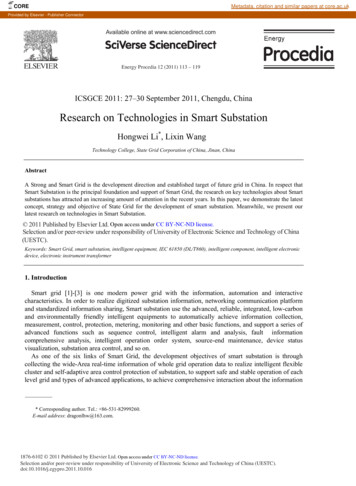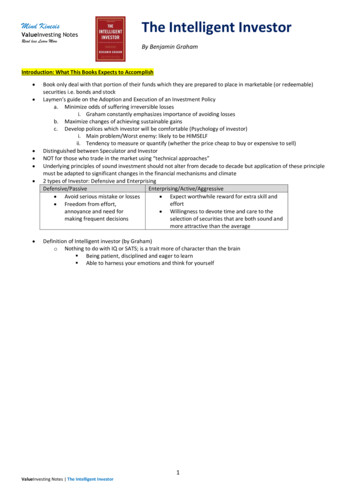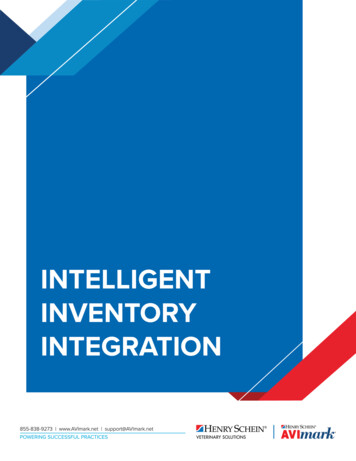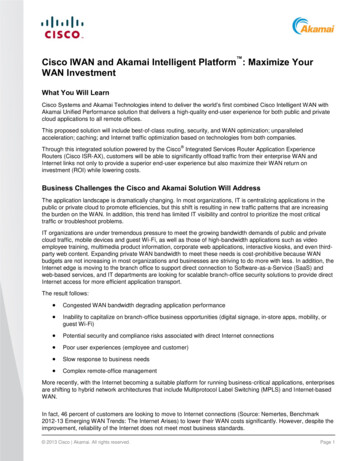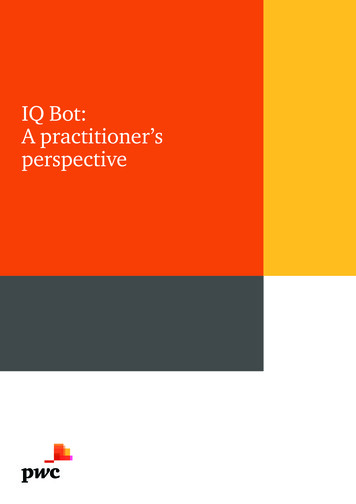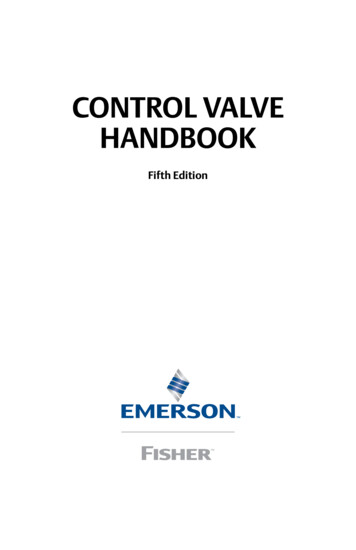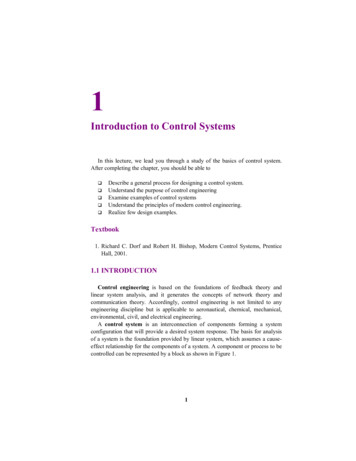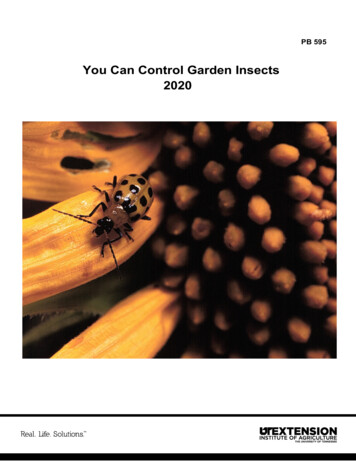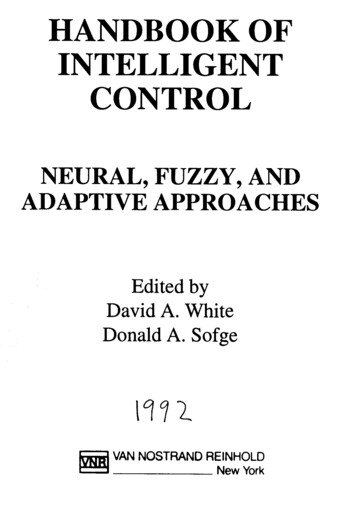
Transcription
HANDBOOK OFINTELLIGENTCONTROLNEURAL, FUZZY, ANDADAPTIVE APPROACHESEdited byDavid A. WhiteDonald A. Sorge\ 1l VAN NOSTRAND REINHOLDNew York
FOREWORD1This book is an outgrowth of discussions that got started in at least three workshops sponsored by theNational Science Foundation (NSF):.Aworkshop on neurocontrol and aerospace applications held in October 1990, under jointsponsorship from McDonnell Douglas and the NSF programs in Dynamic Systems and Controland Neuroengineering.A workshop on intelligent control held in October 1990, under joint sponsorship from NSF andthe Electric Power Research Institute, to scope out plans for a major new joint initiative inintelligent control involving a number of NSF programs.A workshop on neural networks in chemical processing, held at NSF in January-February 1991,sponsored by the NSF program in Chemical Reaction ProcessesThe goal of this book is to provide an authoritative source for two kinds of information:(1) fundamental new designs, at the cutting edge of true intelligent control, as well as opportunitiesfor future researchto improve on these designs; (2) important real-world applications, including testproblems that constitute a challenge to the entire control community. Included in this book are aseriesof realistic test problems, worked out through lengthy discussions between NASA, NetJroDyne,NSF, McDonnell Douglas, and Honeywell, which are more than just benchmarks for evaluatingintelligent control designs. Anyone who contributes to solving these problems may well be playinga crucial role in making possible the future development of hypersonic vehicles and subsequently theeconomic human settlement of outer space.This book also emphasizes chemical process applications(capable of improving the environment as well as increasing profits), the manufacturing of high-qual ity composite parts, and robotics.The term "intelligent control" has beenused in a variety of ways, some very thoughtful, and somebased on crude attempts to market aging software. To us, "intelligent control" should involve bothintelligence and control theory. It should be based on a serious attempt to understand and replicatethe phenomenathat we have always called "intelligence"-i.e., the generalized, flexible, and adaptivekind of capability that we see in the human brain. Furthermore, it should be firmly rooted in controltheory to the fullest extent possible; admittedly, our development of new designs must often be highlyintuitive in the early stages, but, once these designs are specified, we should at least do our best tounderstandthem and evaluate them in terms of the deepestpossible mathematical theory. This booktries to maintain that approach.1 The viewsexpressedhere arethoseof the authorsanddo not representofficial NSFviews.The figureshavebeenusedbeforein public talks by the first author.xi
xiiHANDBOOK OF INTELLIGENT CONTROLFigure F.lNeurocontrolasa subset.Traditionally, intelligent control has embraced classical control theory, neural networks, fuzzylogic, classical AI, and a wide variety of search techniques (such as genetic algorithms and others).This book draws on all five areas, but more emphasis has been placed on the first three.Figure F.l illustrates our view of the relation between control theory and neural networks.Neurocontrol, in our view, is a subset both of neural network research and of control theory. Noneof the basic design principles used in neurocontrol is totally unique to neural network design; theycan all be understood-and improved-more effectively by viewing them as a subset and extensionof well-known underlying principles from control theory. By the same token, the new designsdeveloped in the neurocontrol context can be applied just as well to classical nonlinear control. Thebulk of the papers on neurocontrol in this book discuss neurocontrol in the context of control theory;also, they try to provide designs and theory of importance to those control theorists who have nointerest in neural networks as such. The discussion of biology may be limited here, but we believethat these kinds of designs-designs that draw on the power of control theory-are likely to be morepowerful than some of the simpJer,more naive connectionist models of the past; therefore, we suspectthat they will prove to be more relevant to actual biological systems, which are also very powerfulcontrollers. These biological links have been discussed extensively in other sources, which are citedin this book.Those chapters that focus on adaptive control and neurocontrol implicitly assume the followingdefinition: Intelligent control is the use of general-purpose control systems, which learn over timehow to achieve goals (or optimize) in complex, noisy, nonlinear environments whose dynamics must
/0VARIABLESt-00TO 00LINEARNONLINEAR1/0 LIMITSFigure F.2 Aspectsof intelligent control,ultimately be learned in real time. This kind of control cannot be achieved by simple, incrementalimprovements over existing approaches. It is hoped that this book provides a blueprint that will makeit possible to achieve such capabilities.Figure F.2 illustrates more generally our view of the relations between control theory, neurocontrol,fuzzy logic, and AI. Just as neurocontrol is an innovative subset of control theory, so too is fuzzylogic an innovative subset of AI. (Some other parts of AI belong in the upper middle part of FigureF.2 as well, but they have not yet achieved the same degree of prominence in engineering applica tions.) Fuzzy logic helps solve the problem of human-machine communications (in querying experts)and formal symbolic reasoning (to a far less extent in current engineering applications).In the past, when control engineers mainly emphasized the linear case and when AI was primarilyBoolean, so-called intelligent control was mainly a matter of cutting and pasting: AI systems andcontrol theory systems communicated with each other, in relatively ad hoc and distant ways, but thefit was not very good. Now, however, fuzzy logic and neurocontrol both build nonlinear systems,based on continuous variables bounded at 0 and 1 (or il). From the controller equations alone, itbecomesmore and more difficult to tell which system is a neural system and which is a fuzzy system;the distinction begins to become meaningless in terms of the mathematics. This moves us towards anew era, where control theory and AI will become far more compatible with eachother. This allowsL 1 arrangementslike what is shown in Figure F.3, where neurocontrol and fuzzy logic can be used astwo complementary sets of tools for use on one common controller.,II t./1: !:ari .':8!!'P:
xiv HANDBOOK OF INTELLIGENT CONTROLJ FUZZY TOOLS.NEURO TOOLSFigure F.3A wayto combinefuzzy andneuraltools.@§ORDS?HUMANFROM EXPERTUMANFUZZY!! OTHER?NEURO Figure F .4 A wayto combinefuzzyandneuraltools.! SHAPING
FOREWORDxvIn practice,thereare manyways to combinefuzzylogic and otherforms of AI with neurocontroland otherforms of control theory. For example,seeFigure F.4.This book will try to provide the basic tools and examplesto make possiblea wide variety ofcombinationsand applications,andto stimulatemoreproductivefuture research.Paul J. WerbosNSF ProgramDirector for NeuroengineeringandCo-directorfor EmergingTechnologiesInitiationElben MarshNSF DeputyA.D. for EngineeringandFormerProgramDirector for DynamicSystemsand ControlKishanBahetiNSF ProgramDirector for EngineeringSystemsandLead ProgramDirector for the Intelligent ControlInitiativeMaria BurkaNSF ProgramDirector for ChemicalReactionProcessesHoward MoraffNSF ProgramDirector for RoboticsandMachineIntelligence
3NEUROCONTROLANDSUPERVISED LEARNING:AN OVERVIEW ANDEVALUATIONPaull. WerbosNSF Program Director for NeuroengineeringCo-director for Emerging Technologies Initiation]3.1.INTRODUCTIONAND SUMMARY3.1.1. General CommentsThis chapter will present detailed procedures for using adaptive networks to solve certain commonproblems in adaptive control and system identification. The bulk of the chapter will give examplesusing artificial neural networks (ANNs), but the mathematics are general. In place of ANNs, one canuse any network built up from differentiable functions or from the solution of systems of nonlinearequations. (For example, section 3.2 will show how one can apply these procedures to econometricmodels, to fuzzy logic structures, etc.) Thus. the methods to be developed here are really part oflearning control or adaptive control in the broadest sense. For those with no background in neuralnetworks, it may be helpful to note that everything in this chapter may be viewed as approximationsor extensions of dynamic programming or to other well-known techniques, developed to make itpossible to handle large, noisy, nonlinear problems in real time, and to exploit the computationalpower of special-purpose neural chips.In the past, many applications of ANNs to control were limited to the use of static or feedforwardnetworks, adapted in relatively simple ways. Many applications of that sort encountered problemssuchas large error rates or limited application or slow adaptation. This chapter will try to summarizeI Theviewsexpressedherearethoseof the author,and not the official views of NSF.65
66HANDBOOKOF INTELLIGENT CONTROLthese problems and their solutions. Many of these problems can be solved by using recurrentnetworks, which are essentially just networks in which the output of a neuron (or the value of anintermediate variable) may depend on its own value in the recent past. Section 3.2 will discussrecurrent networks in more detail. For adaptation in real time, the key is often to use adaptive criticarchitectures, as in the successful applications by White and Sofge in Chapters 8 and 9. To makeadaptive critics learn quickly on large problems, the key is to use more advanced adaptive critics,which White and Sofge have used successfully, but have not been exploited to the utmost as yet.3.1.2. Neurocontrol:FiveBasicDesignApproachesNeurocontrol is defined as the use of well-specified neural networks-artificialor natural-to emitactual control signals. Since 1988, hundreds of papers have been published on neurocontrol, butvirtually all of them are still based on five basic design approaches:.Supervisedcontrol, where neural nets are trained on a database that contains the "correct"control signals to use in sample situations.Directinverse control, where neural nets directly learn the mapping from desired trajectories(e.g., of a robot arm) to the control signals which yield these trajectories (e.g., joint angles) [1,2].Neural adaptive control, where neural nets are used instead of linear mappings in standardadaptive control (see Chapter 5).The backpropagation of utility, which maximizes some measure of utility or performance overtime, but cannot efficiently account for noise and cannot provide real-time learning for verylarge problems [3,4,5].Adaptive critic methods, which may be defined as methods that approximate dynamic program ming (i.e., approximate optimal control over time in noisy, nonlinear environments)Outside of this framework, to a minor extent, are the feedback error learning scheme by Kawato[6] which makes use of a prior feedback controller in direct inverse control, a scheme by McAvoy(see Chapter 10) which is a variant of the backpropagation of utility to accommodate constraints, and"classical conditioning" schemesrooted in Pavlovian psychology, which have not yet demonstratedan application to optimal control or other well-defined control problems in engineering [7]. A fewother authors have treated the problem of optimal control over time as if it were a simple functionminimization problem, and have used random search techniques such as simulated annealing orgenetic algorithms.Naturally there are many ways to combine the five basic designs in complex real-world applica tions. For example, there are many complex problems where it is difficult to find a good controllerby adaptation alone, starting from random weights. In such problems, it is crucial to use a strategycalled "shaping." In shaping, one first adapts a simpler controller to a simplified version of theproblem, perhaps by using a simpler neurocontrol approach or even by talking to an expert; then, oneuses the weights of the resulting controller as the initial values of the weights of a controller to solvethe more complex problem. This approach can, of course, be repeated many times if necessary. Onecan also build systems that phase in gradually from a simpler approach to a more complex approach.Hierarchical combinations of different designs are also discussed in other chapters of this book.
NEUROCONTROLIAND SUPERVISEDLEARNING67All of the five basic methods have valid uses and applications, reviewed in more detail elsewhere[8,9]. They also have important limitations.Supervised control and direct inverse control have beenreinvented many times, because they bothcan be performed by directly using supervised learning, a key concept in the neural network field.All forms of neurocontrol use supervised learning networks as a basic building block or module inbuilding more complex systems. Conceptually, we candiscuss neurocontrol without specifying whichof the many forms of supervised learning network we use to fill in these blocks in our flow charts; asa practical matter, however, this choice has many implications and merits some discussion. Theconcept of propagating derivatives through a neural network will also be important to later parts ofthis book. After the discussion of supervised learning, this chapter will review current problems witheach of the five design approaches mentioned above. ,3.2.SUPERVISED LEARNING:,jDEFINITIONS,NOTATION,AND CURRENT ISSUES3.2.1. SupervisedLearning and Multilayer PerceptronsMany popularized accounts of ANNs describe supervised learning as if this were the only task thatANNs can perform.Supervised learning is the task of learning the mapping from a vector of inputs, X(t), to a vectorof targets or desired outputs, Y(t). "Learning" means adjusting a vector of weights or parameters, W,in the ANN. "Batch learning" refers to any method for adapting the weights by analyzing a fixeddatabaseof X(t) and Y(t) for times t from t I through T. "Real-time learning" refers to a method foradapting the weights at time t, "on the fly," as the network is running an actual application; it inputsX(t) and then Y(t) at each time t, and adapts the weights to account for that one observation.Engineers sometimes ask at this point: "But what is an ANN?" Actually, there are many forms ofANN, each representing possible functional forms for the relation that maps from X to Y. In theory,we could try to do supervised learning for any function or mapping! such that:,. !(X, W).(1)Some researchers claim that one functional form is "better" than another in some universal sense forall problems; however, this is about as silly as those economists who claim that all equations musthave logarithms in them to be relevant to the real world.Most often, the functional mapping from X to Y is modeled by the following equations:X; X;I i m(2)m i N n(3);-1net; L W;jXjj 1Xi 1/(1 exp (-net;»'.m i N n(4)
68HANDBOOK i Xi NOF INTELLIGENT CONTROL1 i n ,(5)where m is the number of inputs, n is the number of outputs, and N is a measureof how big you chooseto make the network. N-n is the number of "hidden neurons," the number of intermediate calculationsthat are not output from the network.Networks of this kind are normally called "multilayer perceptrons" (MLP). Becausethe summationin equation 3 only goes up to i-I, there is no "recurrence" here, no cycle in which the output of a"neuron" (Xi)depends on its own value; therefore, these equations are one example of a "feedforward"network. Some authors would call this a "backpropagation network," but this confuses the meaningof the word "backpropagation," and is frowned on by many researchers. In this scheme, it is usuallycrucial to delete (or zero out) connections Wipwhich are not necessary.For example, many researchersuse a three-layered network, in which all weights Wijare zeroed out, except for weights going fromthe input layer to the hidden layer and weights going from the hidden layer to the output layer.3.2.2. Advantagesand Disadvantagesof Alternative Functional FormsConventional wisdom states that MLPs have the best ability to approximate arbitrary nonlinearfunctions but that backpropagation-the method used to adapt them-is much slower to convergethan are the methods used to adapt alternative networks. In actuality, the slow learning speed has alot to do with thefunctionalform itself rather than the backpropagation algorithm, which can be usedon a wide variety of functional forms.MLPs have several advantages: (1) given enough neurons,they can approximate any well-behavedbounded function to an arbitrarily high degree of accuracy, and can even approximate the lesswell-behaved functions needed in direct inverse control [10]; (2) VLSI chips exist to implementMLPs(and several other neural net designs) with a very high computational throughput, equivalent to Crayson a chip. This second property is crucial to many applications. MLPs are also "feedforward"networks, which means that we can calculate their outputs by proceeding from neuron to neuron (orfrom layer to layer) without having to solve systems of nonlinear equations.Other popular forms offeedforward neural networks include CMAC (see Chapters 7 and 9), radialbasis functions (see Chapter 5), and vector quantization methods [11]. These alternatives all have akey advantage over MLPs that I would call exclusivity: The network calculates its output in such away that only a small number of localized weights have a strong effect on the output at anyone time.For different regions of the input-space (the space of X), different sets of weights are invoked. Thishas tremendous implications for real-time learning.In real-time learning, there are always dangers of thrashing about as the system moves from onelarge region of state-spaceto another, unlearning what it learned in previous regions [12].For example, in learning a quadratic function, a system may move occasionally from one regionto another; if a linear approximation fits well enough within anyone region, the system may virtuallyignore the quadratic terms while simply changing its estimates of the linear terms as it moves fromregion to region. It may take many cycles through the entire spacebefore the network begins to exploitthe quadratic terms. Networks with exclusivity tend to avoid this problem, becausethey adapt differentweights in different regions; however, they also tend to contain more weights and to be poor atj
NEUROCONTROLAND SUPERVISEDLEARNING69generalizing across different regions. See Chapter 10 for a full discussion of reducing the number ofweights and its importance to generalization.Backpropagation, and least squaresmethods in general, has shown much better real-time learningwhen applied to networks with high exclusivity. For example, DeClaris has reported faster learning(in feedforward pattern recognition) using backpropagation with networks very similar to radial basisfunctions [13]. Jacobs et al. [14], reported fast learning, using a set of MLPs, coordinated by amaximum likelihood classifier that assumes that each input vector X belongs to one and only oneMLP. Competitive networks [15]-a form of simultaneous-recurrent network-also have a highdegree of exclusivity. From a formal mathematical point of view, the usual CMAC learning rule isequivalent to backpropagation (least squares) when applied to the CMAC functional form.To combine fast learning and good generalization in real-time supervised learning, I once proposedan approach called "syncretism" [16], which would combine: (I) a high-exclusivity network, adaptedby ordinary real-time supervised learning, which would serve in effect as a long-term memory; (2) amore parsimonious network, trained in real time but also trained (in occasional periods of batch-like"deep sleep") to match the memory network in the regions of state-spacewell-represented in memory.Syncretism is probably crucial to the capabilities of systems like the human brain, but no one hasdone the research needed to implement it effectively in artificial systems. Ideas about learning and generalization from examples, at progressively higher levels of abstraction, as studied in human[psychology and classical AI, may be worth reconsidering in this context. Syncretism can work only!in applications-like supervised learning-where high-exclusivity networks make sense.Unfortunately, the most powerful controllers cannot have a high degree of exclusivity in all oftheir components. For example, there is a need for hidden units that serve as feature detectors (foruse across the entire state-space),as filters, as sensor fusion layers, or as dynamic memories. Thereis no way to adapt such units as quickly as we adaptthe output nodes. (At times, one can learn featuressimply by clustering one's inputs; however, this tends to break down in systems that truly have a highdimensionality-such as to-in the set of realizable states, and there is no guarantee that it willgenerate optimal features.) Human beings can learn to recognize individual objects very quickly (inone trial), but even they require years of experience during infancy to build up the basic featurerecognizers that underlie this ability.This suggests that the optimal neural network, even for real-time learning, will typically consistof multiple layers, in which the upper layer can learn quickly and the lower layer(s) must learn moreslowly (or even off-line). For example, one may build a two-stage network, in which the first stageis anMLP-a design well-suited for generalized feature extraction; the output of the MLP could thenbe used as the input to a differentiable CMAC, such as the one developed by Sofge and White [17].iFinally, one can achieve even more computational power-at the cost of even more difficult!adaptation-by adding recurrence to one's networks. There are actually two forms of recurrentnetworks: (I) time-lagged recurrent networks (TLRNs), in which neurons may input the outputs fromany other neurons (or from themselves) from a previous clock cycle; (2) simultaneous-recurrentnetworks, which still perform a static mapping from X to Y, but are based on a kind of iterativerelaxation process. TLRNs are essential when building neural networks for system identification, oreven for the recognition of dynamic patterns. This chapter will show how TLRNs for systemidentification are essential to all forms of neurocontrol, but it will not show how to adapt them; thosedetails are provided in Chapter 10, which will also discuss how to combine time-lagged recurrence
70HANDBOOKOF INTElliGENTCONTROLand simultaneous recurrence in a single network. On the other hand, since simultaneous-recurrentnetworks are essentially just another way to define a static mapping, they will be discussed further atthe end of this section.3.2.3. Methodsto AdaptFeedforwardNetworksThe most popular procedure for adapting ANNs is called basic backpropagation. Figure 3.1 illustratesan application of this method to supervised control, where the inputs (X) are usually sensorreadingsand the targets (u.) are desired control responses to those sensor readings. (In this application, thetargets Y happen to be control signals u.)At each time t, basic backpropagation involves the following steps:I. Use equations 1 through 4 to calculate u(t).2. Calculate the error:nE (t) 112 L ( i (t) Yi (t» 2.(6)i 13. Calculate the derivatives of error with respect to all of the weights, WijoThese derivatives maybe denoted as F -Wij. (This kind of notation is especially convenient when working withmultiple networks or networks containing many kinds of functions.)4. Adjust the weights by steepestdescent:Wij (T I) Wij (t) -LR* F Wij (t),(7)where LR is a learning rate picked arbitrarily ahead of time, or adapt the weights by some othergradient-based technique [18,19].Backpropagation, in its most general form, is simply the method used for calculating all thederivatives efficiently, in one quick backwards sweep through the network, symbolized by the dashedline in Figure 3.1. Backpropagation can be applied to any network of differentiable functions. (SeeChapter 10.) Backpropagation in this sense has many uses that go far beyond the uses of basicbackpropagation.X(t )w aWiy( t)aEaUiFigure 3.1Basic backpropagationin supervisedcontrol.(" '\- !!.: L- .J
NEUROCONTROLAND SUPERVISEDLEARNING71Conventional wisdom states that basic backpropagation--or gradient-based learning in general is a very slow but accuratemethod. The accuracy comes from the minimization of square error, whichis consistent in spirit with classical statistics. Because of the slow speed, backpropagation issometimes described as irrelevant to real-time applications.In actuality, steepestdescent can converge reasonably rapidly, if one takes care to scale the variousweights in an appropriate way and if one uses a reasonable method to adapt the learning rate [20].For example, I have used backpropagation in a real production system that required convergence tofour decimal places in less than forty observations [5], and White and Sofge have reported the use ofbackpropagation in an Action network in real-time adaptation [17]. Formal numerical analysis hasdeveloped many gradient-based methods that do far better than steepest descent in batch learning,but for real-time learning at O(N) cost per time period there is still very little theory available.Based on these considerations, one should at least replace equation 7 by:W;j(t l) W;j(t) -LR(t)* Sij * F W;j(t),(8)where the Sij are scaling factors. We do not yet know how best to adjust the scaling factorsautomatically in real time, but it is usually possible to build an off-line version of one's controlproblem in order to experiment with the scaling factors and the structure of the network. If the scalingfactors are set to speed up learning in the experiments, they will usually lead to much faster learningin real time as well. To adapt the learning rate, one can use the procedure [5]:LR(t l) a*LR(t) b*LR(t)*(F& "\"'j& ;'\'jWft l'. FWft'),(9)I F W(t) Iwhere a and b are constants and the dot in the numerator refers to a vector dot product.Theoretically, a and b should be 1, but in batch learning experiments I have found that an "a" of0.9 and a "b" of.2 or so usually work better. With sparse networks, equation 9 is often enough byitself to yield adequate performance, even without scaling factors.In some applications (especially in small tests of pattern classification!), this procedure will bedisturbed by an occasional "cliff' in the error surface, especially in the early stages of adaptation. Tominimize this effect, it is sometimes useful to create a filtered average of IF -WJ2and scale down anygradient whose size exceeds this average by a factor of 3 or more; in the extreme, one may evennormalize the gradient to unit length. Likewise, in real-time learning applications, the past gradientin equation 9, F W(t), should probably be replaced by some kind of filtered value. Once again, thereare more rigorous and powerful methods available for batch learning [18,19], but they have yet to beextended to real-time learning.A crucial advantage of equation 9 is that it can be applied separatelyto separate groups of weights.For example, one can use equation 9 to independently adapt a different learning rate for differentlayers of a network. This is crucial to many practical applications, where hidden and/or recurrentlayers require slow adaptation.To complete this section, I must show how to calculate the derivatives, F -W;J.t), in equation 8. Forany differentiable feedforward network, one may perform these calculations as follows:
72HANDBOOKOF INTELLIGENT CONTROLF':: Y j (t) I(t) -Yj(t)(10)a j (t){F Wj)(t)} FJW X, W, Y),(11)where F Jw is a function calculated by the dual subroutine of the neural network/.Appendix B of Chapter 10 explains how to program the dual subroutine for any differentiablefeedforward network. In the special case of MLPs, the equations for the dual subroutine are:F Xj(t) F - N- n;-,.{t) L j * F net)(t)(12)i N m, ., 1j i lF netj (t) s'(netj (t» * F -Xj (t)F Wjj(t) F netj(t) * Xj(t),i N m, ., m 1(13)all Wjj(14)where:s '(netj (t» Xj (t) * (1 -Xj (t» ,(15)where the first term on the right-hand side of equation 12 is taken as zero for i N, and where F ne is taken as zero for j m. Notice how this dual subroutine would generate two useful output arrays,F Wand F X (which is the same as F Xi for i m); the main inputs to the dual subroutine are simplythe three arguments of the dual function used in equation 11. (The terms Xjand netj,needed in equations13 and 14, can either be recalculated from X and Wor retrieved from a previous run of the originalnetworkfbased on the same X and W.)Likewise, for a two-stage network where j f(z) and z g(X, W), we can calculate the requiredderivatives simply by calling the dual subroutines for the two subnetworks! and g:FJ. F-h (z, F- t){F Wjj}(16) F gw(X,W,F z).Few researchers have actually used dual subroutines in adapting simple MLPs for patternrecognition. It is easierjust to code equations 10, 12, 13, 14, and 15 into one big subroutine. However,in complex control applications, dual subroutines are essential in order to maintain understandablemodular designs. Intuitively, dual subroutines may be thought of as subroutines that propagatederivatives (any derivatives) back from the outputs of a network to its inputs. They backpropagate toall of the inputs in one sweep, but to represent them as functions we need to u
This book draws on all five areas, but more emphasis has been placed on the first three. Figure F.l illustrates our view of the relation between control theory and neural networks. Neurocontrol, in our view, is a subset both of neural network research and of control theory. None of the ba

